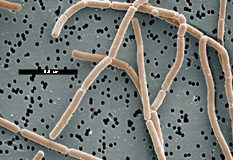Lactobacillus delbrueckii: Difference between revisions
imported>Kiran A. Bharwani No edit summary |
imported>Kiran A. Bharwani No edit summary |
||
| Line 43: | Line 43: | ||
==Genome structure== | ==Genome structure== | ||
Lactobacillus delbrueckii has a circular genome and is made up of 1,864,998 nucleotides. It has a GC content of 49% and has 2,217 genes. Of the 2,217 genes 1,562 code for proteins such as prtB and the lac operon. These proteins contribute to the homofermentative properties observed in L. delbrueckii. The genes that are encoded to take up and break down lactose are the lacS, lacZ, and lac R genes located within the lac operon. Transport of lactose through the membrane is the primary responisibility of lactose permease that is coded by the lacS gene. On the other hand, the lacZ gene, encodes the enzyme B-galactosidase need to metabolize lactose. | |||
==Cell structure and metabolism== | ==Cell structure and metabolism== | ||
Describe any interesting features and/or cell structures; how it gains energy; what important molecules it produces. | [['''Describe any interesting features and/or cell structures; how it gains energy; what important molecules it produces.''']] | ||
==Ecology== | ==Ecology== | ||
L. delbrueckii bulgaricus, a subspecie of Lactobacillus delbrueckii is found to have a symbiotic relationship with Streptococcus thermophilus. Together they coexist in starter lactic acid bacteria cultures. The lactic acid that is produced also contributes in preserving milk. L. delbrueckii are also symbiotic with the gastrointestinal tract and vagina of humans. | L. delbrueckii bulgaricus, a subspecie of Lactobacillus delbrueckii is found to have a symbiotic relationship with Streptococcus thermophilus. Together they coexist in starter lactic acid bacteria cultures. The lactic acid that is produced also contributes in preserving milk. L. delbrueckii are also symbiotic with the gastrointestinal tract and vagina of humans. | ||
| Line 59: | Line 57: | ||
==Application to Biotechnology== | ==Application to Biotechnology== | ||
Two subspecies of Lactobacillus delbrueckii, L. delbrueckii bulgaricus and L. delbrueckii lactis play a major role in the dairy industry. Fermented yogurt, milk, and cheese are cultured from these two subspecies. If the process of fermentation that occurs through L. delbrueckii bulgaricus and L. delbrueckii lactis came to a halt it would result in a large economic loss. This is why care must be taken to keep the conditions of production constant. | Two subspecies of Lactobacillus delbrueckii, L. delbrueckii bulgaricus and L. delbrueckii lactis play a major role in the dairy industry. Fermented yogurt, milk, and cheese are cultured from these two subspecies. If the process of fermentation that occurs through L. delbrueckii bulgaricus and L. delbrueckii lactis came to a halt it would result in a large economic loss. This is why care must be taken to keep the conditions of production constant. | ||
Revision as of 15:16, 2 April 2008
Articles that lack this notice, including many Eduzendium ones, welcome your collaboration! |
| Lactobacillus delbrueckii | ||||||||||||||
|---|---|---|---|---|---|---|---|---|---|---|---|---|---|---|
| [[image: | ]] | |||||||||||||
| Scientific classification | ||||||||||||||
|
Classification
Higher order taxa
Domain: Bacteria; Phylum: Firmicutes; Class: Bacilli; Order: Lactobacillales; Family: Lactobacillaceae
Species
L. delbrueckii
Description and significance
L. delbrueckii is a gram positive bacteria. It is long, filamentous and non-motile. The environment in which L. delbrueckii thrives the most would be one of relatively low pH, preferring acidic enviornments. L. delbrueckii undergoes obligate homofermtentative metabolism which means they are only able to ferment lactose and no other sugar. In addition, they can able to survive in an environment which has oxygen present.
In 1905, Stamen Grigoroy, a Bulgarian doctor, discovered L. delbrueckii...
Include a picture or two (with sources) if you can find them.
Genome structure
Lactobacillus delbrueckii has a circular genome and is made up of 1,864,998 nucleotides. It has a GC content of 49% and has 2,217 genes. Of the 2,217 genes 1,562 code for proteins such as prtB and the lac operon. These proteins contribute to the homofermentative properties observed in L. delbrueckii. The genes that are encoded to take up and break down lactose are the lacS, lacZ, and lac R genes located within the lac operon. Transport of lactose through the membrane is the primary responisibility of lactose permease that is coded by the lacS gene. On the other hand, the lacZ gene, encodes the enzyme B-galactosidase need to metabolize lactose.
Cell structure and metabolism
Ecology
L. delbrueckii bulgaricus, a subspecie of Lactobacillus delbrueckii is found to have a symbiotic relationship with Streptococcus thermophilus. Together they coexist in starter lactic acid bacteria cultures. The lactic acid that is produced also contributes in preserving milk. L. delbrueckii are also symbiotic with the gastrointestinal tract and vagina of humans.
Pathology
Unlike most microbes, L. delbrueckii is non-pathogenic. It is the source that provides milk, yogurt, cheese, and vegetables.
Application to Biotechnology
Two subspecies of Lactobacillus delbrueckii, L. delbrueckii bulgaricus and L. delbrueckii lactis play a major role in the dairy industry. Fermented yogurt, milk, and cheese are cultured from these two subspecies. If the process of fermentation that occurs through L. delbrueckii bulgaricus and L. delbrueckii lactis came to a halt it would result in a large economic loss. This is why care must be taken to keep the conditions of production constant.
Current Research
Enter summaries of the most recent research here--at least three required
References
